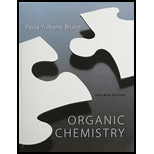
(a)
Interpretation:
Major elimination product for given reaction if the product exists as stereoisomers is to be identified.
Concept Introduction:
Zaitsev’s Rule: States that the more substituted
(b)
Interpretation:
Major elimination product for given reaction if the product exists as stereoisomers is to be identified.
Concept Introduction:
Zaitsev’s Rule: States that the more substituted alkene is obtained when a hydrogen from is removed from the
(c)
Interpretation:
Major elimination product for given reaction if the product exists as stereoisomers is to be identified.
Concept Introduction:
Zaitsev’s Rule: States that the more substituted alkene is obtained when a hydrogen from is removed from the
(d)
Interpretation:
Major elimination product for given reaction if the product exists as stereoisomers is to be identified.
Concept Introduction:
Zaitsev’s Rule: States that the more substituted alkene is obtained when a hydrogen from is removed from the
(e)
Interpretation:
Major elimination product for given reaction if the product exists as stereoisomers is to be identified.
Concept Introduction:
Zaitsev’s Rule: States that the more substituted alkene is obtained when a hydrogen from is removed from the
(f)
Interpretation:
Major elimination product for given reaction if the product exists as stereoisomers is to be identified.
Concept Introduction:
Zaitsev’s Rule: States that the more substituted alkene is obtained when a hydrogen from is removed from the
Trending nowThis is a popular solution!

Chapter 10 Solutions
Organic Chemistry & Study Guide and Student Solutions Manual for Organic Chemistry, Books a la Carte Edition (7th Edition)
- Treating 4-penten-1-ol with bromine in water forms a cyclic bromoether. Account for the formation of this product rather than a bromohydrin as was formed in Problem 6.33arrow_forwardWhen 2-bromo-3-phenylbutane is treated with sodium methoxide, two alkenes result (by E2 elimination). The Zaitsevproduct predominates.(a) Draw the reaction, showing the major and minor products.(b) When one pure stereoisomer of 2-bromo-3-phenylbutane reacts, one pure stereoisomer of the major product results.For example, when (2R,3R)-2-bromo-3-phenylbutane reacts, the product is the stereoisomer with the methyl groups cis.Use your models to draw a Newman projection of the transition state to show why this stereospecificity is observedarrow_forwardWhen 2-bromo-3-phenylbutane is treated with sodium methoxide, two alkenes result (by E2 elimination). The Zaitsevproduct predominates.(a) Draw the reaction, showing the major and minor products.(b) When one pure stereoisomer of 2-bromo-3-phenylbutane reacts, one pure stereoisomer of the major product results.For example, when (2R,3R)-2-bromo-3-phenylbutane reacts, the product is the stereoisomer with the methyl groups cis.Use your models to draw a Newman projection of the transition state to show why this stereospecificity is observed.(c) Use a Newman projection of the transition state to predict the major product of elimination of (2S,3R)-2-bromo-3-phenylbutanearrow_forward
- what is the product of 1-Hexyne reacting with 1 equivalent of HBr? Include E/Z if necessary.arrow_forwardWhich of the following is product of A? How about B? a Cyclopentene oxide b 1,1-epoxycyclopentane c 1,2-hydroxycyclopentane d Cyclopentoxypentane What is the name of reaction 1? a hydration b hydrate formation c acid cleavage d epoxidation What is the name of reaction 2? a ring-opening reaction with Nu b hydration c Williamson ether synthesis d oxidationarrow_forwardDraw the product you expect from the reaction of (R)-2-bromooctane with CH3CO2-. Be sure to show stereochemistryarrow_forward

 Organic Chemistry: A Guided InquiryChemistryISBN:9780618974122Author:Andrei StraumanisPublisher:Cengage Learning
Organic Chemistry: A Guided InquiryChemistryISBN:9780618974122Author:Andrei StraumanisPublisher:Cengage Learning Organic ChemistryChemistryISBN:9781305580350Author:William H. Brown, Brent L. Iverson, Eric Anslyn, Christopher S. FootePublisher:Cengage Learning
Organic ChemistryChemistryISBN:9781305580350Author:William H. Brown, Brent L. Iverson, Eric Anslyn, Christopher S. FootePublisher:Cengage Learning


